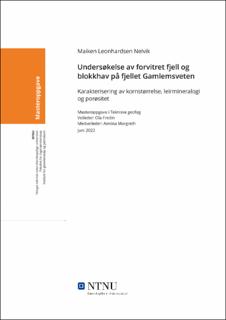| dc.contributor.advisor | Fredin, Ola | |
| dc.contributor.advisor | Margreth, Annina | |
| dc.contributor.author | Nelvik, Maiken | |
| dc.date.accessioned | 2022-10-11T17:19:38Z | |
| dc.date.available | 2022-10-11T17:19:38Z | |
| dc.date.issued | 2022 | |
| dc.identifier | no.ntnu:inspera:114862279:37263981 | |
| dc.identifier.uri | https://hdl.handle.net/11250/3025438 | |
| dc.description.abstract | Gamlemsveten er et fjell utenfor Ålesund dekket av tilsynelatende steddannet blokkhav og flere meter med forvitringsmateriale. Forvitret grunnfjell har tidligere vært gode olje- og gassreservoarer, hvor porøsitet er en avgjørende egenskap. Å beregne porøsitet til løsmasser som viser in situ strukturer er problematisk både ved felt- og laboratorieundersøkelser. I denne oppgaven testes derfor metoder for å ta kjerneprøver av løsmasser, og metoder for å beregne porøsitet. Metodene som testes er mikro-røntgendatatomgrafi (mCT) og elektronmikroskop (SEM).
Opprinnelsen til blokkhav og finkornet forvitringsmaterialet i alpine og nordlige landskap kan forklares gjennom to motstående teorier; den pre-kvartære (neogene) teorien og den periglasiale teorien. I denne oppgaven vurderes opprinnelsen basert pa observasjoner fra felt og resultater fra røntgendiffraksjon (XRD), SEM og kornfordelingsanalyse opp mot eksisterende litteratur og tidligere arbeider.
Resultatene fra mCT og SEM viser at dette er gode metoder for å visualisere, studere strukturer og beregne porøsitet til prøver av løsmasser med et høyt detaljnivå. Derimot var det vanskelig å bestemme in situ porøsitet til forvitringsmaterialet, da løsmassene er forstyrret ved tørking og epoksy-impregnering i forkant av analysene. Basert på kornfordelingsanalysen, som viser et finkornet og velgradert materiale, har forvitringsmaterialet en lav porøsitet.
XRD og SEM analysene fant at forvitringsmaterialet fra Gamlemsveten inneholder gibbsitt. Dette bekrefter professor emeritus Jan Mangerud sitt funn av det samme mineralet pa 1980- tallet. Gibbsitt kan være en indikasjon på forvitring i neogen tid, men observasjoner fra feltarbeid og resultater fra XRD, SEM og kornfordelingsanalysen viser at dannelsen sannsynligvishar foregatt ved periglasiale prosesser gjennom kvartær tid. | |
| dc.description.abstract | Gamlemsveten is a mountain north-east of Ålesund covered by apparently locally formed blockfields and several meters of weathering material. Weathered bedrock has previously been good oil and gas reservoirs, where porosity is a crucial property. Calculating porosity for loose materials that show in situ structures is problematic in both field and laboratory investigations. This thesis therefore tests methods for taking core samples of loose materials, and methods for calculating porosity. The methods tested are micro-X-ray computed tomography (mCT) and electron microscopy (SEM).
The origin of blockfields and fine-grained weathering material in alpine and northern landscapes can be explained through opposing theories; the pre-Quaternary (neogene) theory and the periglasial theory. In this thesis, the origin is assessed based on observations from fields and results from X-ray diffraction (XRD), SEM and grain size distribution analysis. The results are compared to existing literature and previous work.
The results from mCT and SEM show that these are good methods for visualizing, studying structures and calculate porosity on samples of loose materials with a high level of detail. It turns out to be difficult to determine in situ porosity of the weathering material by these methods, as the loose materials were disturbed by drying and epoxy impregnation before the analyzes. Based on grain size distribution analysis, which shows a fine-grained and well-graded material, it is expected that the material has a low porosity.
The XRD and SEM analyzes found that the weathering material from Gamlemsveten contains
gibbsite. This is confirmed by Professor Emeritus Jan Mangerud’s discovery of the same mineral in the 1980s. Gibbsite may be an indication of weathering in neogenic time, but observations
from fieldwork and results from XRD, SEM and the grain distribution analysis show that the
formation has probably taken place by periglasial processes through Quaternary time. | |
| dc.language | nob | |
| dc.publisher | NTNU | |
| dc.title | Undersøkelse av forvitret fjell og blokkhav på fjellet Gamlemsveten
- Karakterisering av kornstørrelse, leirmineralogi og porøsitet | |
| dc.type | Master thesis | |
